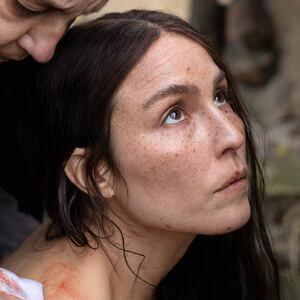Imagine, for a moment, that the latent anger you harbored as a teen suddenly sprouted its own body. Who would it have attacked first? In Finnish director Hanna Bergholm’s feature debut, Hatching, the carnage piles up fast.
Hatching (Pahanhautoja) follows a 12-year-old girl named Tinja (Siiri Solalinna), whose influencer mother (Sophia Heikkilä) is extremely concerned about her success as a gymnast (mostly as an extension of her own brand) and not much else. From the outside, Tinja’s life glimmers with the allure of a fairytale. Who would ever question the happiness of that family of four down the street in the cute little house with its gorgeous wallpaper? Especially when all of it appears to be captured for posterity on a video blog!
Cue the exquisitely unsubtle metaphor of a crow crashing into the family’s window.
ADVERTISEMENT
Like many a foolish, young horror protagonist before her, Tinja ventures into the woods at night to find the injured bird her mother had (seemingly) already killed before her eyes earlier. She seems to make short work of putting the shrieking creature out of its misery—but we soon find out that it’s not the bird who needs a gesture of mercy.
Tinja is crumbling under her mother’s impossible expectations and harsh rebukes that she must do better—mostly in gymnastics during the film, but one gets the sense that this perfectionism extends to a lot more than that. Her little brother (Oiva Ollila) is, as younger bros are wont to be, a mistrustful and meddlesome little twerp. And her father (Jani Volanen) is a checked-out zombie in a cardigan—which might be why her mother’s chief passion in life, beyond bullying her daughter, is gushing to her about the man she’s having an affair with.
In other words, our dear Tinja is living in a millennial pink emotional powder keg, and puberty is the match that sets it ablaze—well, and that damn crow, whose egg she discovers and brings home. She nurtures the speckled spawn with warmth until it grows as big as she is.
Bergholm’s direction relishes visual gags—for instance, a girl on the cusp of puberty clandestinely spooning a giant egg while listening to her careless mother’s musings on how life as a woman is all expectations and no reciprocal care. Maneuvers like these imbue the film with a sense of humor that’s been missing from too many releases in the era of so-called “elevated horror”—a cheeky sensibility that only escalates after Tinja’s demon spawn hatches.
Tinja’s feathered friend is born a grotesque and emaciated middle ground between human and bird—a warbling mess of patchy feathers, gangly limbs, and slobbery (snotty?!) beak. The practical effects used to bring this critter to life are immaculate enough to earn her a place in the “funny little guy” creature-feature canon alongside classics like The Fly, Gremlins, and, yes, Critters. One of Hatching’s greatest accomplishments is the slow, unsettling revelation of what, precisely, this creature is growing into. (No spoilers here on that front!)
Things start to fly south when Tinja’s bird friend—whom she names Alli—starts attacking people (and other critters) who’ve wronged her.
Tinja’s relationship with this physical manifestation of all her rage and frustration is, as one might imagine, pretty fraught! The tween’s shit list is long, and while she appears to have a degree of control over Alli’s behavior, she, too, is mostly at Alli’s mercy. Another telling, less humorous visual metaphor: Tinja must prepare Alli’s food by regurgitating her own meals, a replication of bulimia that feels apt given not only the perfectionist environment in which Tinja lives but also her involvement in gymnastics.
The seamless coordination of Hatching’s writing, direction, and production would do any influencer proud. Screenwriter Ilja Rautsi and director Bergholm work hand-in-hand to develop the film’s wickedly arch tone, while costume designer Ulrika Sjölin and production designer Päivi Kettunen appear to be working from the same mood board to ensure that whatever Tinja’s mother might be wearing complements the backdrop at all times. The glamorous design of Tinja’s family home, even her bedroom, belie its soullessness; the youngster’s walls are covered in gorgeous wallpaper but none of the cutesy, warm decorations one might expect in the room of a child whose own interests and tastes have been encouraged.
But the ultimate highlight of this accomplished debut feature is the young performer at its center. First-time actress Solalinna captures the precariousness of her character’s early adolescence with astounding nuance. With a mere shift in gaze, the actress can toggle between the fragile neediness of a child and the stifled rage of a scorned teenager. And toward the end of the film, she’s downright terrifying. A family counselor might suggest that this family find a peaceful, more empathetic way to get along—but in this case, Tinja has chosen violence.






